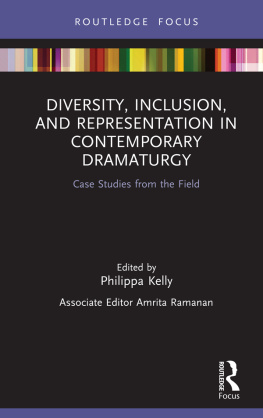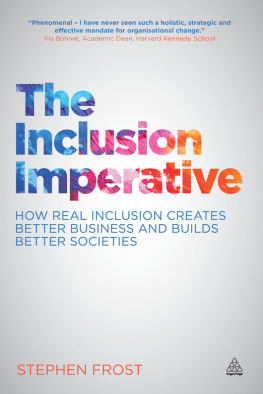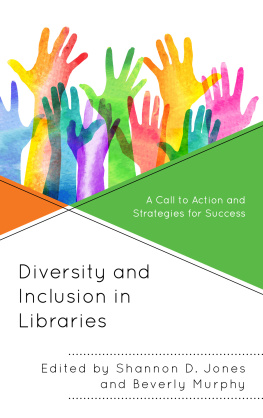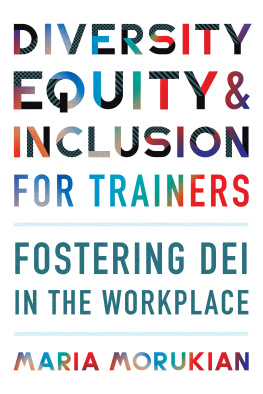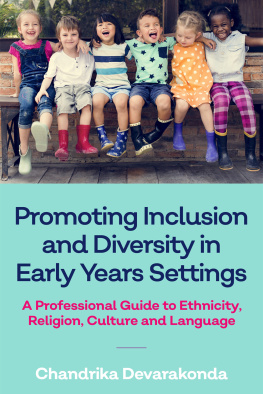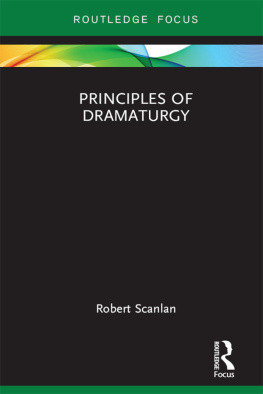Philippa Kelly - Diversity, Inclusion, and Representation in Contemporary Dramaturgy
Here you can read online Philippa Kelly - Diversity, Inclusion, and Representation in Contemporary Dramaturgy full text of the book (entire story) in english for free. Download pdf and epub, get meaning, cover and reviews about this ebook. year: 2020, publisher: Taylor and Francis, genre: Home and family. Description of the work, (preface) as well as reviews are available. Best literature library LitArk.com created for fans of good reading and offers a wide selection of genres:
Romance novel
Science fiction
Adventure
Detective
Science
History
Home and family
Prose
Art
Politics
Computer
Non-fiction
Religion
Business
Children
Humor
Choose a favorite category and find really read worthwhile books. Enjoy immersion in the world of imagination, feel the emotions of the characters or learn something new for yourself, make an fascinating discovery.
- Book:Diversity, Inclusion, and Representation in Contemporary Dramaturgy
- Author:
- Publisher:Taylor and Francis
- Genre:
- Year:2020
- Rating:3 / 5
- Favourites:Add to favourites
- Your mark:
- 60
- 1
- 2
- 3
- 4
- 5
Diversity, Inclusion, and Representation in Contemporary Dramaturgy: summary, description and annotation
We offer to read an annotation, description, summary or preface (depends on what the author of the book "Diversity, Inclusion, and Representation in Contemporary Dramaturgy" wrote himself). If you haven't found the necessary information about the book — write in the comments, we will try to find it.
Philippa Kelly: author's other books
Who wrote Diversity, Inclusion, and Representation in Contemporary Dramaturgy? Find out the surname, the name of the author of the book and a list of all author's works by series.
Diversity, Inclusion, and Representation in Contemporary Dramaturgy — read online for free the complete book (whole text) full work
Below is the text of the book, divided by pages. System saving the place of the last page read, allows you to conveniently read the book "Diversity, Inclusion, and Representation in Contemporary Dramaturgy" online for free, without having to search again every time where you left off. Put a bookmark, and you can go to the page where you finished reading at any time.
Font size:
Interval:
Bookmark:
We are honored to have commissioned this book with the invitation and support of Routledge Focus on Dramaturgy Series Editor Magda Roman-ska, funded by an inaugural Bly Award for Innovation in Dramaturgy from the Literary Managers and Dramaturgs of the Americas. Mark Bly, Brian Quirt, Cindy SoRelle, Martine Kei Green-Rogers, and the Literary Managers and Dramaturgs of the Americas (LMDA) have been a source of enduring and inspirational support. Special thanks to Sylvia Abrams, Emily Stone and Kate Van Riper, who stepped in at the end to give expert assistance with proofreading, and to Michael Chemers, who contributed patient and excellent reviews. Thanks also to designer Annie Smart, composer Paul Dresher, philosophers Chandran Kukathas and Martin Krygier, and (philosophically driven) Sharyn Charnas for their invaluable comments.
We are thrilled beyond words to have commissioned a series of chapters that emerge from the rich soil of theater-making to express and explore the possibilities opened up by dramaturgical creativity. And from the editors perspective, through every single collaboration, I have learned far more than I have contributed.
Philippa Kelly and Amrita Ramanan
April 2020
Deconstructing our perspectives on casting
Faedra Chatard Carpenter
In the world of theater, many are quick to think of casting in terms of the procedures and politics framing the assignment of performing artists actors, singers, and/or dancers to specific roles. Subsequently, the recognition of embodied or expressed differences, particularly as they may relate to what is visible to spectators (that is, corporeal markers of race, gender, age, size, ability, etc.) is always in consideration, both implicitly and explicitly. Whether or not casting choices are made with conscientious determination or with willful ignorance of their possible interpretive consequences, producing artists can never fully control the reception of their intentions: rather, they can only hope to avoid potential misinterpretations.
While one may not think of casting as a multifarious concept in theater, it is. The matter of casting is not limited to what bodies we see when the proverbial curtain rises. It also pertains to a productions unseen yet undeniable impresarios most notably, designers and directors. With the exception of those who self-appoint (for example, an artistic director who has the means to determine the directing assignments they will or will not take on), artistic leadership is also cast. These appointments offer the same possibilities and pitfalls as when designating performers to particular roles or characters.
Whether one is selected as a consultant, dramaturg, designer, choreographer, or director, individuals have been cast in given roles as executors of artistic intentions. Consequently, their casting is aimed toward yet another form of casting: these chosen artists are charged with shaping what we see, hear, and feel. They are tasked to fit and fill a creative vision. These various renditions of casting always involve maneuvers of inclusion and exclusion. Casting can be understood as an act of luring, baiting. It is a method used to attract, compel, and catch particular impulses or interpretations. And just as there is the state of being cast in, there is also the dynamic of being cast out precluded, dismissed, and even freed.
Like a status indicator on Facebook, casting can be complicated.
Beginning with this comprehensive understanding of casting and grounded in my firm belief that casting is always a dramaturgical consideration this interview/article (or inter-article) invites readers to contemplate how artistic leadership is often cast and how deviations from all-too-typical practices challenge both audiences and production stakeholders to confront narrow ways of thinking and doing. By fully recognizing the role of casting when it comes to artistic leadership, I hope to highlight how diversions from traditional expectations must be considered and championed in order to bring forth greater equity and manifest inclusive opportunities. In so doing, I lean on a conversation I recently had with a theater artist that I have known for quite a while and for whom I hold a great deal of admiration: Hana S. Sharif.
Hana S. Sharif made history in July 2018 when she was named the Artistic Director of the Repertory Theatre of St. Louis, becoming the first African American woman to lead a major League of Resident Theaters (LORT) playhouse. Acknowledging Sharifs groundbreaking appointment, this inter-article is propelled by the hope that Sharif will not simply be known as one of a very few stellar anomalies in the annals of American theater history; rather, it is my hope that Sharifs appointment will help serve as a catalyst that opens the gate for other female, African American artistic directors. Serving as a generative example of non-traditional casting within the frame of artistic leadership, Sharifs experiences disclose the casting politics that still encumber our institutions, as well as the promising possibilities that abound when we are willing to deconstruct old perspectives about who is prepared to lead us into the future of American theater.
In 2015, I served as the dramaturg for Pride and Prejudice by Christopher Baker, a world premier adaptation directed by Baltimore Center Stages (then) Associate Artistic Director, Hana S. Sharif (). In our first dramaturgical meeting, Sharif emphasized two things: her great passion for the works of Jane Austen (she is able to speak on all six novels with vigor and insight) and her creative vision for this particular production. In discussing her vision for the play, Sharif highlighted the ways in which Austen artfully protested against the commodification of womens bodies and consistently created female characters that defy expectations. With specific reference to Pride and Prejudice, Sharif repeatedly expressed how Austens novel prompts us to contemplate the role of social status in crafting our belief-systems. Accordingly, the premise of deconstructing perspectives shaped how she saw the impulses and architecture of the characters lives.

Hana S. Sharif, Director of Pride and Prejudice, Baltimore Center Stage, 2015
Source: Photography credit Bill Geenen
Carrying the premise and motif of deconstructing perspectives to the staging and design of Baltimore Center Stages Pride and Prejudice, Sharif directed the creation of a set that animated multiple ways of seeing. This was done through the use of picture frames and scenic windows that transformed to expose alternative scenes and simultaneous happenings, as well as through the employment of canvas panels that were either lit in order to become transparent enough to reveal moments behind closed doors or made opaque so as to host projections and filmed vignettes. The design inspired by Sharifs vision incorporated both live bodies and mediated images of various characters and, through its use of shadows and silhouettes, conjured the art of the controversial (yet ever-fascinating) Kara Walker. This montage of imagery propelled the design to break through expectations of realism and invite a strategic clashing of perspectives. With its mix of genres, locations, and temporalities, the design activated Sharifs intent to retell a well-known story full of familiar characters in a fresh and unexpected way.
Without a doubt, Sharifs creative vision for Pride and Prejudice informed the design palettes of the production, impacting elements related to set, costume, music, movement, lighting, and projection. Yet Bakers adapted text still paid due homage to the original novel, and, with deliberate consciousness, the actors were cast with an intentional adherence to the world as Austen envisioned it. In other words, the actors were all white folk. What proved to be surprising to some, however, was the fact that the all-white cast of
Font size:
Interval:
Bookmark:
Similar books «Diversity, Inclusion, and Representation in Contemporary Dramaturgy»
Look at similar books to Diversity, Inclusion, and Representation in Contemporary Dramaturgy. We have selected literature similar in name and meaning in the hope of providing readers with more options to find new, interesting, not yet read works.
Discussion, reviews of the book Diversity, Inclusion, and Representation in Contemporary Dramaturgy and just readers' own opinions. Leave your comments, write what you think about the work, its meaning or the main characters. Specify what exactly you liked and what you didn't like, and why you think so.

